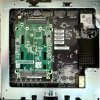There's a working option to add one more M.2 slot to the MS-01 without using the PCIe slot or the Wi-Fi M.2 slot.
I installed the QNAP QDA-U2MP using the M.2 to U.2 adapter that comes with the MS-01. The QNAP enclosure needs to be removed for the card to fit. It's a tight fit, but is easy to do. It works well: you can put the original fan/plate back and close the case normally, no clearance issues. While there’s not enough space for individual SSD heatsinks, the original MS-01 fan/plate acts as one.
With an external fan blowing on the side of the MS-01, the two SSDs in the QNAP adapter idle at around 55°C, which is actually cooler than the SSDs in slot 2 and 3 (those have heatsinks and idle at around 60C).
EDIT : I ended up removing the heatsink on the 3rd SSD (the one closest to the WiFi card), to prevent it from obstructing the fan. I hadn't noticed it at first, but realized the 2nd and 3rd SSDs were getting unusually hot. Doing this lowered the idle SSD temp by 10°C vs before. Thank you @randman for the tip.
Downsides:
hack option.



I installed the QNAP QDA-U2MP using the M.2 to U.2 adapter that comes with the MS-01. The QNAP enclosure needs to be removed for the card to fit. It's a tight fit, but is easy to do. It works well: you can put the original fan/plate back and close the case normally, no clearance issues. While there’s not enough space for individual SSD heatsinks, the original MS-01 fan/plate acts as one.
With an external fan blowing on the side of the MS-01, the two SSDs in the QNAP adapter idle at around 55°C, which is actually cooler than the SSDs in slot 2 and 3 (those have heatsinks and idle at around 60C).
EDIT : I ended up removing the heatsink on the 3rd SSD (the one closest to the WiFi card), to prevent it from obstructing the fan. I hadn't noticed it at first, but realized the 2nd and 3rd SSDs were getting unusually hot. Doing this lowered the idle SSD temp by 10°C vs before. Thank you @randman for the tip.
Downsides:
- The controller in the QNAP downgrades the link to PCIe 3.0 x4 (instead of PCIe 4.0 x4).
- It’s still relatively expensive compared to using an M.2 riser on the Wi-Fi slot or a PCIe M.2 expansion card.



Last edited:

